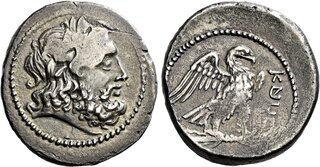| Numismatica Ars Classica > Auction 146 | Auction date: 8 May 2024 |
| Lot number: 2009 Price realized: This lot is for sale in an upcoming auction - Bid on this lot  | Show similar lots on CoinArchives Find similar lots in upcoming auctions on |
| Lot description: Campania, Capua. Reduced quadrigatus circa 213-211, AR 21 mm, 6.03 g. Laureate head of Zeus r. Rev. kapu in Oscan characters Eagle standing r. on thunderbolt. Sambon 1021. de Luynes 105. Robinson, NC 1964, pl. 5, 1 (these dies). SNG ANS 200. Historia Numorum Italy 480. Extremely rare, only very few specimens known. An issue of great interest and fascination with a superb old cabinet tone and a portrait of fine style. Areas of weakness, otherwise about extremely fine / good very fine Ex Hess-Leu 28, 1965, 8 and NAC 13, 1998, formerly exhibited at the Antikenmuseum Basel, 33 sales. From the Athos and Dina Moretti collection. Although originally founded by the Etruscans, Capua was apparently seized by a group of Samnites in the fifth century BC. These came to be known as Campanians after the name of the city, which is variously said to derive from Etruscan capeva, apparently meaning "city of marshes," Latin campus (field), or caput (head). In the fourth century, Capua supported the Latin cause against the Romans in the Latin War (340-338 BC) and suffered defeat, leading to the loss of parts of its territory, including the Falernian Plain, which was renowned for the wine that it produced. The Campanians of Capua were further bound to Rome by a grant of Roman citizenship without voting rights. When the Second Punic War (218-201 BC) broke out, Capua was second only to Rome in terms of wealth and prestige, but its people chafed under the necessity of subservience to the Romans. The crushing Roman defeat at the Battle of Cannae (216 BC) seemed to offer an opportunity. With the Romans in dire straits, a Campanian embassy was sent to Rome asking for Capua to be recognised as an equal partner with one of the annual consuls to be elected from the city. This request was denied and instead the Campanians opened their gates to Hannibal in the hope that through the destruction of Rome Capua would become the preeminent city in Italy. Capua remained the preferred winter quarters for Hannibal until 211 BC, when the city was finally besieged and captured by the Roman army commanded by the proconsul Q. Fulvius Flaccus. As punishment for the city's betrayal of Rome, the elite citizens of Capua were executed or imprisoned while the rest of the population was deported. Much of the city's agricultural territory was seized as public land of the Roman state while the city itself was given over to others. There was room for only one great city on the Italian peninsula and Rome was determined to be it. This extremely rare silver issue was struck during Capua's support for Hannibal and reflects in its representation of Jupiter and his eagle on a thunderbolt the city's keen desire to be Rome's replacement. The types are very Roman in flavour and the representation of the eagle is almost identical to that found on emergency gold multiples (Crawford 44/2) struck by the Romans during the Second Punic War. However, the legend makes it clear that this is not a Roman coinage, but that of its alter ego. It does not exclaim ROMA in Latin characters as on other Roman coins, but instead names Capua in distinctive Oscan script. Estimate: 7500 CHF |  |



